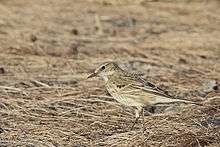Water pipit
| Water pipit | |
|---|---|
 | |
| Scientific classification | |
| Kingdom: | Animalia |
| Phylum: | Chordata |
| Class: | Aves |
| Order: | Passeriformes |
| Family: | Motacillidae |
| Genus: | Anthus |
| Species: | A. spinoletta |
| Binomial name | |
| Anthus spinoletta (Linnaeus, 1758) | |
The water pipit (Anthus spinoletta) is a small passerine bird which breeds in the mountains of southern Europe and southern temperate Asia across to China. It is a short-distance migrant moving to wet open lowlands such as marshes and flooded fields in winter. Some birds migrate north to Britain for winter, taking advantage of the warm oceanic climate.
Like most other pipits, this is an undistinguished looking species on the ground, mainly brown above and dark streaked buff below. It has dark legs, white outer tail feathers and a longish dark bill. In summer it has a distinctive breeding plumage, with a pinkish breast, grey head and pale supercilium.[2][3]

The Eurasian rock pipit's subspecies littoralis in summer plumage is very close in outward appearance to the water pipit. They can be told apart by their song,[4] and occupy different habitat types even when they occur in the same general area.[5] The water pipit is also much less approachable than the Eurasian rock pipit, rising high and quickly leaving the vicinity when approached. Water and buff-bellied pipit do not co-occur except in a small area in Central Asia.[6]
This species is insectivorous. Its call is an explosive "fit", like Eurasian rock pipit. Its song is similar, but it consisting of maybe 5 "blocks" of just about half a dozen notes each (the Eurasian rock pipit has fewer, but longer blocks); it ends either with no or with repeated trills.[5]
Formerly included in the water pipit were the subspecies now separated as rock pipit and buff-bellied pipit.[7] The former is more closely related to the water pipit than the latter, as indicated by external[2] and molecular characteristics.[8]
References
- ↑ BirdLife International (2012). "Anthus spinoletta". IUCN Red List of Threatened Species. Version 2013.2. International Union for Conservation of Nature. Retrieved 26 November 2013.
- 1 2 Per Alström & Krister Mild (1996). "The identification of Rock, Water and Buff-bellied Pipits". Alula 2 (4): 161–175.
- ↑ Per Alström & Krister Mild (1987). Some notes on the taxonomy of the Water Pipit complex. Proceedings of the 4th International Identification Meeting. Eilat: International Birdwatching Center. pp. 47–48.
- ↑ V. V. Leonovich, G. V. Deminia & O. D. Veprintseva (1997). "On the taxonomy and phylogeny of pipits (Genus Anthus, Motacillidae, Aves) in Eurasia". Biulleten Moskovskogo obshchestva ispytatelei prirody. Otdel biologicheskii (in Russian) 102 (2): 14–22.
- 1 2 R. Bijlsma (1977). "Voorkomen en oecologie van Anthus spinoletta en A. s. littoralis in de uiterwaarden van de Rijn bij Wageningen". Limosa (in Dutch) 50: 127–136.
- ↑ A. A. Nazarenko (1978). "On species validity of Anthus rubescens Tunstall (Aves: Motacillidae)". Zoologicheskiy Zhurnal (in Russian) 57: 1743–1744.
- ↑ George Sangster, Alan G. Knox, Andreas J. Helbig & David T. Parkin (2002). "Taxonomic recommendations for European Birds". Ibis 144 (1): 153–159. doi:10.1046/j.0019-1019.2001.00026.x.
- ↑ G. Voelker (1999). "Molecular evolutionary relationships in the avian genus Anthus (Pipits: Motacillidae)". Molecular Phylogenetics and Evolution 11 (1): 84–94. doi:10.1006/mpev.1998.0555. PMID 10082613.
External links
| Wikimedia Commons has media related to Anthus spinoletta. |
| Wikispecies has information related to: Anthus spinoletta |
- Ageing and sexing (PDF; 3.3 MB) by Javier Blasco-Zumeta & Gerd-Michael Heinze
- Avibase Links in turn to Flckr Handguide
